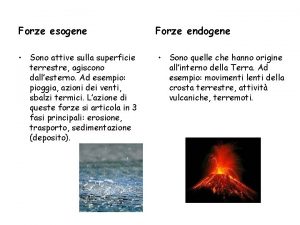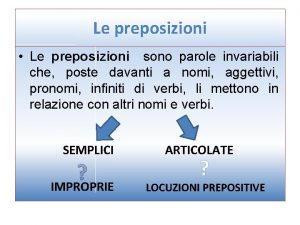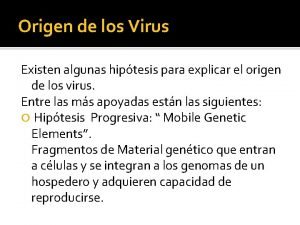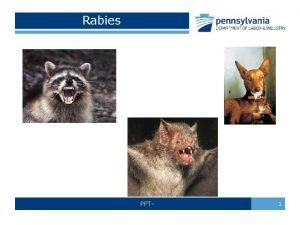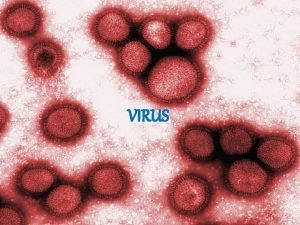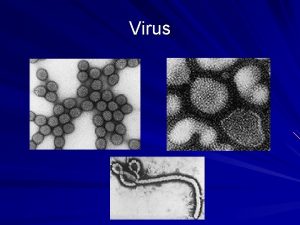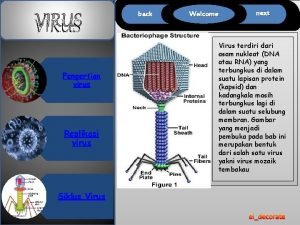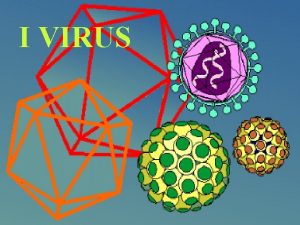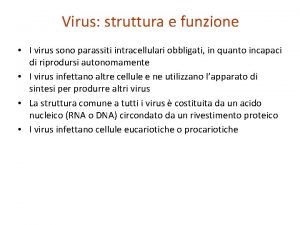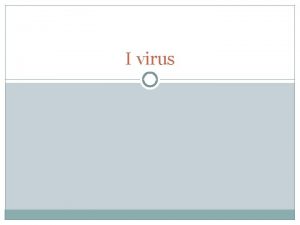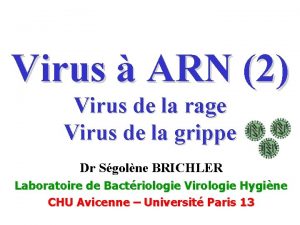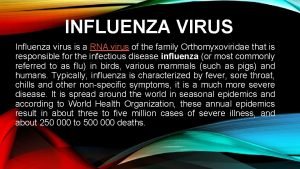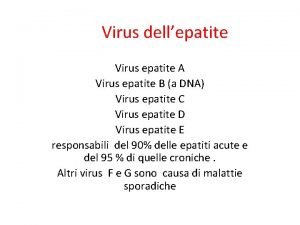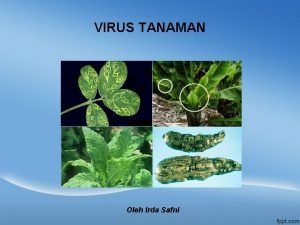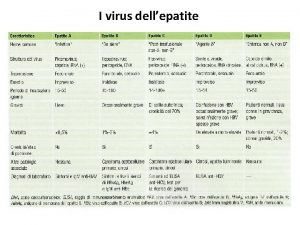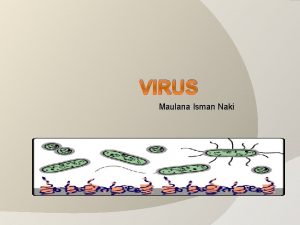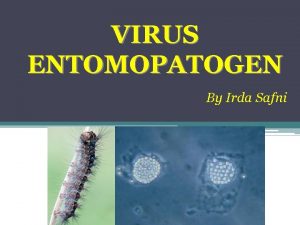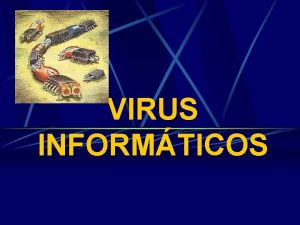i virus sono il creatore nascosto che ha





































- Slides: 37

” i virus sono il creatore nascosto che ha contribuito a renderci umani” Luis Villarreal Parte delle nostre vite in un senso piu’ letterale di quanto immaginiamo e almeno il 30% degli adattamenti evolutivi a livello molecolare è servito a difenderci dai virus. M. Comar Dip. Scienze Mediche, Chirurgiche e della Salute Universita’ degli Studi di Trieste IRCCS-Burlo Garofalo, Trieste

THE VIROME The virome can be described as the set of all viruses that are found in a particular enviroment. It forms part of the microbiome In humans different virome exists since different bacteria communities or microbiome harbor human body

Viruses are parasitic biologic entities that require host cells for replication

The global virome • 107 viruses per ml in sea water • Viruses outnumber hosts by ~10 fold in sea water • 1031 viral particles on Earth • Numerically most successful biological entities Data from Lita Proctor, Forrest Rohwer, Curtis Suttle and others Proctor, 1997

The Human Virome Persistent/latent infections Virus EBV VZV Herpes HSV 1 HPV CMV HSV 2 HIV HCV Transient infections with animal cell viruses seropositive 100% 95% 80% Endogenous retroviruses 8% of human DNA 68% 60% 59% 22% 1% 1% 1010 -1011 per gram of stool Bacteriophage predators of bacteria

EUKARYOTIC ARE RELEVANT AS PATHOGEN CAUSING ACUTE OR PERSISTENT INFECTIONS HESTABLISHING A LONG TERM RELATIONSHIP WITH THE HOST AND INFLUENCE THE INFLAMMATORY STATUS OF THE BODY. OTHER ARE FOUND IN HEALTHY INDIVIDUALS WITHOUT APPARENT DISEASE. MANY SEQUENCES ARE INTEGRATED IN HUMAN GENOME REFFERED AS ENDOGENOUS VIRAL ELEMENTS ( EVES) INCLUDING RETROVIRAL (8%). SOME REMAINS AS COMPLETE ORFS AND SEEM TO BE FUNCTIONAL GAMMARETROVIRUSES HERV-T ENVELOPE SEQUENCES REMAINS FUNCTIONAL IN PRIMATE FOR MILIONS OF YEARS.

BACTERIOPHAGE Role as modulators of bacteriome Direct impact on inflammation as in Crohn’s disease. They can use 2 different cycles communities lytic and lysogenic: to infect and regulate bacterial In the lityc cycle the infection results in the distruction of infected cells and release progeny In the lysogenic cycle , they integrate their genome in host genome as prophage.

Trans-species transfer of viruses: a moving target Graham et al. Nat Rev Microbiol 2013 >80 Mio pet cats worldwide Feline Co-infections common (40% of cats shed >5 viruses in feces) Novel viruses in asymptomatic cats (Sakobuvirus, Bocavirus, Astroviren, Picobirnavirus) Ng et al. Veterinary Microbiol 2013; Benedictis et al. Infection, Genetics, Evolution 2011

The HUMAN VIROME project GVP paper published in Science "Outbreaks of novel and deadly viruses highlight global vulnerability to emerging diseases, with many having massive health and economic impacts. . . Our ability to mitigate disease emergence is undermined by our poor understanding of the diversity and ecology of viral threats, and of the drivers of their emergence. We describe a Global Virome Project (GVP) aimed to launch in 2018 that will help identify the bulk of this viralthreat and provide timely data for public health interventions against future pandemics. "


Cross Assembly phage (2014) the first organism named after metagenomic analysis 6 x more abundant in feces than all other known phages together 90% of all reads in virus-like particle (VLP)-derived metagenomes 22% of total community metagenomes 1. 68% sequences in the database of all human fecal metagenomic sequencing reads in the public databases Year of discovery: 2014 Majority of cr. Assphage-encoded proteins match no known discarded as data junk Dutilh et al. Nat Comm 2014

Eukaryotes virus in symptomatic and asymptomatic individuals

VIRUS in HUMAN BLOOD

The „silent“ human virome Group Family Species ds. DNA Adenoviridae Iridoviridae Myoviridae Podoviridae Siphoviridae Enteric adenovirus 40, 41 Lymphocystis disease virus phi. BCD 7, Bacillus phage G, phi. P-SSM 4 Enterobacteria phage P 22, phage T 3 Listeria phage A 118, phi. E 125 Lactococcus phage b. IL 285, phi. CP 39 -O, Clostridium Phages Papillomaviridae Polyomaviridae Herpesviridae Anelloviridae Circoviridae Microviridae Halophage e. HP-10 Human papillomavirus 6, 18, 66 BK virus, JC virus, SV 40 virus, Human polyomavirus 9, 12, Merkel cell polyomavirus Epstein-Barr virus, Human cytomegalovirus TTV Chicken anemia virus, TN 9, PK 5034, PK 5222, NG 12 ss. DNA ds. RNA Picobirnaviridae Reoviridae (+) ss. RNA Caliciviridae Astroviridae Virgaviridae Picornaviridae Chlamydia phage 1, 3, 4, Bdellovibrio phage phi. MH 2 K, Chlamydia phage CPG 1, Spiroplasma phage 4, Chlamydia phage CPAR 39 Human picobirnavirus Human rotavirus Norwalk virus Human astrovirus Pepper mild mottle virus, Tobacco mosaic virus Cosavirus, Klassevirus/salivirus, Aichi virus, Enterovirus, Parechovirus, Saffold cardiovirus, Echovirus, Coxsackievirus, Poliovirus Popgeorgiev et al. Intervirology 2013; Wylie et al. BMC Biology 2014; Foulongne et al. Plos. One 2012

VIRUS and HUMAN CANCER

VIRUS Integration in Human DNA

HERV-W env (syncytin-1) Physiologic functions of syncytins Inserted in human-prehominoids chromosome 7 q 21, 40 -45 millions years ago Absolute requirement for placenta development and embryo survival Positive selective advantage – switch from egg to uterus Induction of maternal immune tolerance to fetus? Cellular resistance against infection by retroviruses of family spleen necrosis virus Lavialle et al. Phil. Trans. R. Soc. B 2013; Blesa et al. Cancer Therapy 2008 Syncytin gene capture events

Role of HERV-W env (syncytin-1) in human cancer Overexpressed in 76% of urothelial cell carcinoma tissues (controls, 6%) Overexpression increases proliferation and viability of immortalized human uroepithelial cells Involved in mediating cancer-endothelial cell fusions in vitro Syncytin-1 expression = positive prognostic factor in breast cancer Syncytin-1 expression in 38% of all breast cancer samples Upregulated in endometrial carcinoma Yu et al. Oncogene 2014; Blesa et al. Cancer Therapy 2008; Larsson et al. Placenta 2002 Urogenital cancer tissue

1031 phage on earth 10 phage for bacteria 1022 -1024 stars in entire universe

Phage- bacteria predation dynamics or Kill-the winner Phage kill only the dominant bacterial strains to reestablish a microbiological equilibrium. In humans different niche contain stable communities of phage and bacteria as consequence of a predominant phage lysogenic cycle. Es: of role of lytic phage into the development of disease ( periodontitis) Phage-induced bacterial genome modification They offer evolutionary advantage to bacteria by stimulating mutations, adaptations and antibiotic resistance, by horizontal gene transfer. Es: profhage of enterococcus feacalis adhesion to human platelets , first step of infective endocarditis Phage –human immune system dynamics Pahge and microbiota colonize mucosal surface and are considered as part of innate immune system as they provide physical and biochemical antimicrobial defence.

Bacteriophages shape the microbiota of all metazoans

Intestinal Bacteriophages Phages protect from pathogenic Bacteria: co-evolution with metazoan Barr et al. PNAS 2013

The VIROME is more than a source of pathogens THE EMERGING PARADIGM The virome can influence the host in a profound way independent of classical viral disease A systemic virus is inherited from parents very early in life. The virome may be properly seen as a significant part of our individual genetic identity, whether or not the virus is integrated into our chromosome

Virome stimulates low level of immune response in asymptomatic host.


birth mode results in distinctly different viral communities, with Spontaneous Vaginal Delivery infants having greater viral and bacteriophage diversity

Bacterial and virus cooperation…




the vaginal virome was clearly linked with bacterial community structure and BV


The objective of this study was to examine the vaginal eukaryotic DNA virome in a cohort of pregnant women and examine associations between vaginal community characteristics and preterm birth.

virome composition

Having both high bacterial diversity and high viral diversity in the first trimester was associated with the highest risk for preterm birth.


. . Thank you !!!
 La focalizzazione esterna
La focalizzazione esterna Narratore palese o nascosto
Narratore palese o nascosto Forze endogene
Forze endogene I vapordotti sono i tubi che
I vapordotti sono i tubi che Apotecio lecideino
Apotecio lecideino Che cosa sono i centrioli
Che cosa sono i centrioli Undici e un quarto che ore sono
Undici e un quarto che ore sono Cause di giustificazione
Cause di giustificazione Le macchine semplici mappa concettuale
Le macchine semplici mappa concettuale Quali sono i fattori che influenzano il clima
Quali sono i fattori che influenzano il clima Cosa studiano le scienze umane
Cosa studiano le scienze umane Careful avverbio
Careful avverbio Quelli che mi lasciano proprio senza fiato sono i libri
Quelli che mi lasciano proprio senza fiato sono i libri Le proposizioni incidentali
Le proposizioni incidentali I sette sacramenti in ordine
I sette sacramenti in ordine Struttura del testo drammatico
Struttura del testo drammatico Che cosa sono i poligoni
Che cosa sono i poligoni Artropodi cosa sono
Artropodi cosa sono Mappa concettuale forze endogene e esogene
Mappa concettuale forze endogene e esogene Quali sono le preposizioni improprie
Quali sono le preposizioni improprie Quali sono le tic
Quali sono le tic Scusa che ore sono
Scusa che ore sono Quando due numeri si dicono opposti
Quando due numeri si dicono opposti Cosa sono i fuso orari
Cosa sono i fuso orari Che cosa sono i numeri interi
Che cosa sono i numeri interi Quando due figure sono equivalenti?
Quando due figure sono equivalenti? Divisibilit
Divisibilit Che cosa sono le fonti del diritto
Che cosa sono le fonti del diritto Cos'è la figura retorica
Cos'è la figura retorica Principi gestaltici di raggruppamento
Principi gestaltici di raggruppamento Facesti come quei che va di notte che porta il lume
Facesti come quei che va di notte che porta il lume Proposizione subordinata
Proposizione subordinata Ricordo quegli occhi pieni di vita
Ricordo quegli occhi pieni di vita Che che kooley
Che che kooley Origen de los virus
Origen de los virus Rabies ppt
Rabies ppt Siklus virus
Siklus virus Mumps virus
Mumps virus


















